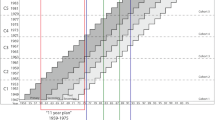Abstract
This study assesses the effect of population change on decade changes in the educational attainments of country of origin populations in the United States. Our data are derived from decennial censuses, NLMS, the World Bank, and INS. We find that changes in the share of country of origin populations with one or more years of post-secondary schooling are associated with selected components of population change during the 1980–1990 and 1990–2000 decades. The specific components include survivors during the decade, in-migration, and emigration of the foreign-born. Likewise, intra-generational mobility is found to be an important determinant of changes in educational attainment. The discussion addresses limitations of the data and suggests directions for future research as well as policy implications.
Similar content being viewed by others
Notes
We exclude residents of group quarters because we cannot distinguish among residents of college dormitories, prisons, and other institutions. Most studies focus on the civilian non-group-quarter population and we follow this approach as well. Given the heterogeneity of this population, we assume that the inclusion of group-quarters populations in our estimates would have weakened the effects found. Moreover, such populations are typically less likely to provide information, thereby amplifying measurement error.
Appendix Table 6 estimates the components of changes for the total population of a region-of-origin category, expressed as a percentage of the mid-decade population of the region of origin.
References
Alba, R. D. (1990). Ethnic identity: The transformation of white America. New Haven: Yale University Press.
Alba, R. D., & Nee, V. (2003). Remaking the American mainstream: Assimilation and contemporary immigration. Cambridge, MA: Harvard University Press.
Barro, R. J., & Lee, J.-W. (2000). International data on educational attainment: Updates and implications. Harvard University, Center for International Development, Working Paper No. 42.
Bobo, L., O’Connor, A., & Tilly, C. (Eds.). (2001). Urban inequality: Evidence from four cities. New York: Russell Sage Foundation.
Chiswick, B. R., & DebBurman, N. (2004). Educational attainment: Analysis by immigrant generation. Economics of Education Review, 23(4), 361–379.
Chiswick, B. R., & Sullivan, T. A. (1995). The new immigrants. In R. Farley (Ed.), State of the union: America in the 1990s, Vol. II: Social Trends (pp. 211–270). New York: Russell Sage Foundation.
Entwisle, D. R., Alexander, K. L., & Olson, L. S. (2005). First grade and educational attainment by Age 22: A new story. American Journal of Sociology, 110(5), 1458–1502.
Featherman, D. L., & Hauser, R. M. (1978). Opportunity and change. New York: Academic Press.
Feliciano, C. (2005). Educational selectivity in U.S. immigration: How do immigrants compare to those left behind? Demography, 42(1), 131–152.
Fischer, C. S., & Hout, M. (2006). Century of difference: How America changed in the last hundred years. New York: Russell Sage Foundation.
Gamoran, A. (2001). American schooling and educational inequality: A forecast for the 21st century. Sociology of Education, 74(Special Issue), 135–153.
Herrnstein, R. J., & Murray, C. (1994). The bell curve: Intelligence and class structure in American life. New York: Free Press.
Hirschman, C. (1983). American’s melting pot reconsidered. Annual Review of Sociology, 9, 397–423.
Hirschman, C. (2001). The educational enrollment of immigrant youth: A test of the segmented-assimilation hypothesis. Demography, 38(3), 317–336.
Jensen, L. (2001). The demographic diversity of immigrants and their children. In R. G. Rumbaut & A. Portes (Eds.), Ethnicities: Children of immigrants in America (pp. 21–56). Berkeley/New York: University of California Press/Russell Sage Foundation.
Leventhal, T., Fauth, R. C., & Brooks-Gunn, J. (2005). Neighborhood poverty and public policy: A 5-year follow-up of children educational outcomes in the New York City moving to opportunity demonstration. Development Psychology, 41(6), 933–952.
Lieberson, S., & Waters, M. C. (1988). From many strands: Ethnic and racial groups in contemporary America. New York: Russell Sage Foundation.
Mare, R. D. (1995). Changes in educational attainment and school enrolment. In: R. Farley (Ed.), State of the union: America in the 1990s (Vol. 1, Economic Trends, pp. 155–213). New York: Russell Sage Foundation.
Massey, D. S. (1999). Why does immigration occur? A theoretical synthesis. In C. Hirschman, J. De Wind, & P. Kasinitz (Eds.), The handbook of international migration: The American experience (pp. 34–52). New York: Russell Sage Foundation.
McLanahan, S. S. (1985). Family structure and the reproduction of poverty. American Journal of Sociology, 90(4), 873–901.
Myers, D. (2005). Cohorts and socioeconomic progress. In R. Farley & J. Haaga (Eds.), The American people: Census 2000 (pp. 139–166). New York: Russell Sage Foundation.
Pappas, G., Queen, S., Hadden, W., & Fisher, G. (1993). The increasing disparity in mortality between socioeconomic groups in the United States, 1960 and 1986. The New England Journal of Medicine, 329(2), 103–109.
Portes, A., & Zhou, M. (1993). The new second generation: Segmented assimilation and its variants. The Annals of the American Academy of Political and Social Science, 530, 74–96.
Redstone, I., & Massey, D. S. (2004). Coming to stay: Analysis of the U.S. census question on immigrants year of arrival. Demography, 41(4), 721–738.
Sorlie, P. D., Backlund, E., & Keller, J. B. (1995). US mortality by economic, demographic, and social characteristics: The National Longitudinal Mortality Study. American Journal of Public Health, 85(7), 949–956.
United States Bureau of the Census. (2008). http://www.census.gov/population/www/socdemo/educ-attn.html, Historical tables, current population survey: Table A-1. Years of school completed by people 25 years and over, by age and sex: Selected years 1940 to 2006; Table A-2. Percent of people 25 years and over who have completed high school or college, by race, Hispanic origin and sex: Selected years, 1940–2006.
Van Hook, J., Weiwei, Z., Bean, F. D., & Passel, J. S. (2006). Foreign-born emigration: A new approach and estimates based matched CPS files. Demography, 43(2), 361–382.
Author information
Authors and Affiliations
Corresponding author
Appendix
Rights and permissions
About this article
Cite this article
Wilson, F.D., Rebhun, U. & Rivas, S. Population Change and Changing Educational Attainment of Ethnic Groups in the United States, 1980–2000. Popul Res Policy Rev 30, 639–659 (2011). https://doi.org/10.1007/s11113-011-9204-7
Received:
Accepted:
Published:
Issue Date:
DOI: https://doi.org/10.1007/s11113-011-9204-7




